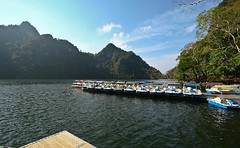The Gua Cerita or "Cave with a Legend" is one of the many fascinating limestone caves situated in the north-east of Langkawi. It comprises two limestone caves, one above the other and faces the sea. There are a number of legends associated with the Gua Cerita, one of which was related to Merong Maha Wangsa in the episode involving the Roman and the Chinese Emperors.
The story goes that the emperors of Rome and China had a plan to marry off their children. The scheme was opposed by the legendary Geruda (phoenix) who saw the union of the two great powers as a threat to the other smaller kingdoms. The Geruda was determined to quash the scheme; what it did was to abduct the Chinese pricess and hid her in a cave believed to be on Langkawi Island. It then set to attack and destroy the Roman fleet commanded by Merong Maha Wangsa with the Roman Prince on it. Merong Maha Wangsa is said to be of mythical origin, the descendents of an indera (a minor divinity) and a gergasi(orge).
During the battle Merong Maha Wangsa summoned the help of Jentayu, the mythical bird of water. However the Geruda was victorious. During the battle the Roman prince fell into the sea and was washed ashore on the island where the Chinese princess was hidden. He was later found by the princess's maids and the couple were finally united in betrothal.
Meanwhile the Geruda had thought he was victorious but came to know later that the couple was united in marriage. In disgrace the Geruda vanished itself from the world.
There are other places in Langkawi with equally interesting and mysterious legends. The Gua Langsiar (Cave of the Banshee), somewhat weird sounding, was believed to be a haven for vampires. The caves with its ghost-like appearance immediately strikes a visitor of the semblance of truth with the legend.




